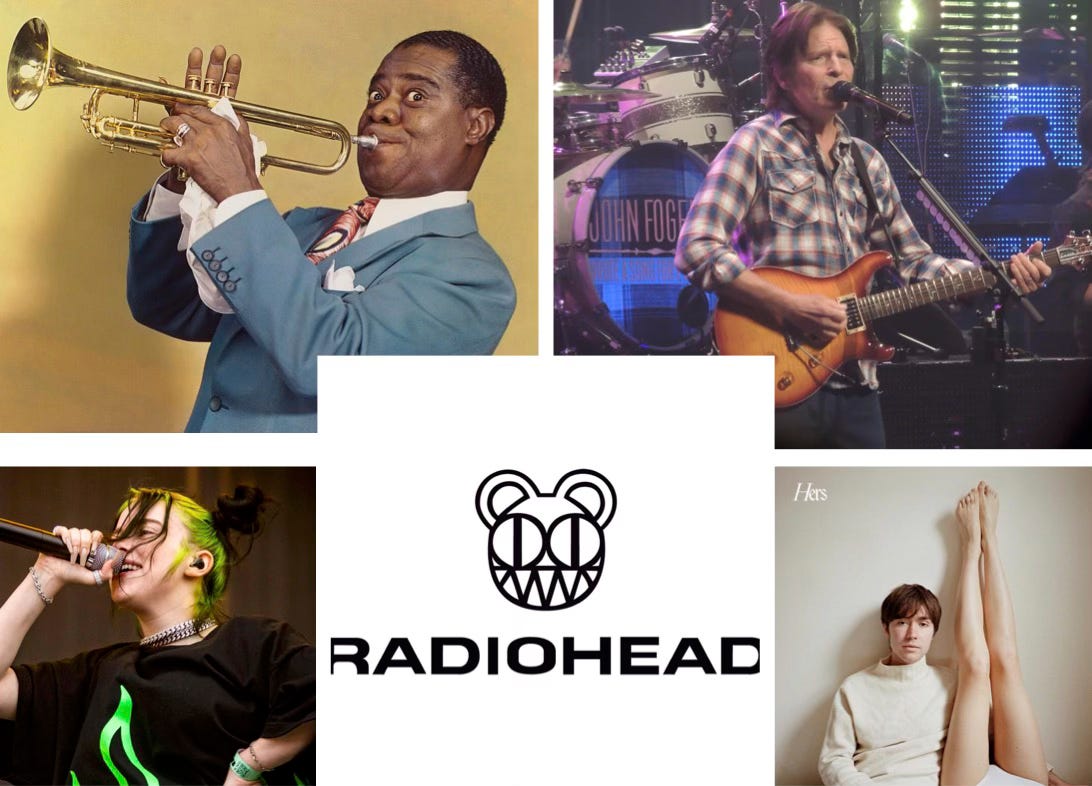“This is what you’ll get when you mess with us.” Those fighting words lilt easily and eerily from the soothing voice of Thom Yorke in Radiohead’s “Karma Police.” Or consider Matt Maltese’s gently bitter line: “There’s always some motherfucker seeking the affection of my girl.”
In my last post, I explored the concept of theme in music and art—the unifying idea or goal of a work—and distinguished it from musical unity, which refers to a coherent emotional atmosphere. Some pieces offer both. Some offer neither. Often, a song is musically unified while thematically muddled—you might find yourself thinking, “The music works, but the lyrics don’t make much sense” (see: most Red Hot Chili Peppers songs).
But what about songs in which the lyrics express a clear idea and the music conveys a distinct mood—yet the two seem to contradict each other?
This came up recently in Weekly Wonderings, a great newsletter of life-serving gems by my friend Carrie-Ann (subscribe if you haven’t already). She noted “the sharp contrast between the extremely happy, bouncy music and the apocalyptic lyrics of ‘Bad Moon Rising’” by John Fogerty.
There are loads of examples of this sort of music-lyrics contrast, and some work better than others. Like, why in the hell do so many supposed “nursery rhymes” seem so dark?
Rock-a-bye, baby, in the treetop
When the wind blows, the cradle will rock
When the bough breaks, the cradle will fall
And down will come baby, cradle and all
Who thought it was a good idea to sing babies to sleep with this? And then there’s “Ring Around the Rosie.” Historians never tire of debating it, but many believe this happy-sounding “children’s song” stems from the bubonic plague that ravaged 15th-century London. It’s dark material—to be sung with a skip in your step.
My favorite example of this contrast is Louis Armstrong’s version of “Mack the Knife.”It’s about a murderous thug who leaves victims “oozin' life” on a sidewalk or sinking to the bottom of a river. Its theme is: Warning—there’s a vicious killer on the loose. The lyrics might aptly be set to something raucous by Black Sabbath or Slipknot or The Warning.
But the music? It’s jubilant. Exuberant. Irresistibly swingy. And it became one of Armstrong’s biggest hits.
So what’s going on? Why does this work?
Because in this case, the contrast serves the theme.
Listen again. If you’re like me, it makes you want to throw on a dapper suit, tip your hat to the ladies, and spin your golden pocket watch by its glittering chain. The song pulls you into the mental world of a 1940s mobster. It gives you a glimpse of life through the eyes of a stone-cold killer—someone too dense to see beyond the immediate moment and thus utterly detached from any thought of consequences.
There are musical reasons this works so well. (Skip ahead if you’re allergic to music theory and don’t care to learn.)The song is in B♭ major—and major keys sound “happy” compared to minor keys. But it leans heavily on the B♭ major 6 chord, which gives the harmony a bittersweet twist. Why? Because the sixth degree of a major scale is also the root of its relative minor—its brooding cousin. (Relative major and minor scales share the same notes but start in different places.) The melody also focuses on—and repeatedly returns to—this sixth note, mixing the “happy” sound of major with a mildly disconcerting contrast. That subtle tension gives the song an unsettling charm—it swings, but it also whispers that something’s off. (There’s much more one could say on this, but we’ll leave it there.)
So even though the music and lyrics seem at odds, they’re integrated in service of the same core idea. The music-lyric contrast doesn’t undermine the theme—it expresses it. The result is unified, purposeful, and memorable.
Some point to Billie Eilish’s “bellyache” as a sort of modern equivalent.
It’s another murder ballad wrapped in a sunny exterior. Built around a beachy acoustic guitar progression, it opens on a cheery C major chord. But it’s actually in E minor, uses only two additional (also minor) chords, and its falling refrain on the word “mind” outlines the E minor scale.
So, unlike “Mack the Knife,” the musical darkness here catches up to the lyrical content. If music-lyric contrast was the goal, Eilish could’ve pushed it further.
What about “Bad Moon Rising?” Does the music-lyric contrast serve the song’s theme? If so, it wasn’t by conscious intent. As Carrie-Ann notes, even Fogerty seemed surprised by it:
“It wasn’t until the band was learning the song that I realized the dichotomy. Here you’ve got this song with all these hurricanes and blowing and raging ruin and all that, but it’s ‘I see a bad moon rising.’ It’s a happy-sounding tune, right? It didn’t bother me at the time.”
Should it bother us now?
This veers us toward another topic—one I’ll explore next time.





Great piece! Thank you for the shout-out, Jon.
That's most pop songs, ain't it? Name a blues, country, or folk song that ISN'T like that to some degree….